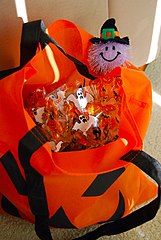
Besides Halloween, can you think of a day that celebrates: Witches and goblins? Ghosts and hobgoblins? Driving past cemeteries in the dead of night? Haunted Houses and Pumpkins Delights? Not to mention children and adults overdosed on sugar?
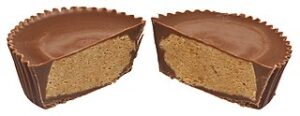
All kinds of fun-sized candy are welcome in the “Trick or Treat” basket. Statistically, the favorite Halloween candy treat is Reese’s Peanut Butter Cups. Chocolate on the outside; creamy peanut butter on the inside. What’s not to like? Yet, Peanut Butter Cups don’t qualify as a Halloween seasonal specialty.
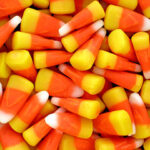
That honor goes to Candy Corn. According to one 2021 survey, Candy Corn won the title of Worst Halloween Candy for the second year in a row. Another survey placed Candy Corn third after chocolate and gummy candy. From this we can infer that surveys are not necessarily accurate.
In terms of consumption, 51 percent of respondents consumed an entire candy corn at once; 33 percent nibbled on the slender white end first, and 17 percent began eating candy corn at the larger yellow end.
Chicken Feed Becomes Candy Corn
Candy Corn has a uniquely American history. George Renniger, an employee of the Wunderlee Candy Company in Philadelphia invented the concoction of sugar, corn syrup, and water, with marshmallow flavoring. The resulting “butter cream” was molded into the shape of a corn kernel. Notice, there was no actual butter or cream in the concoction.
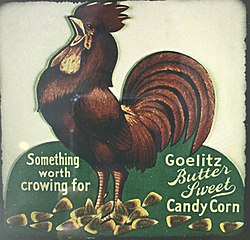
The novelty of this new butter cream was that it could be molded into any shape and was. In addition to corn kernels, there were chestnuts, turnips, pea pods, and four-leaf clovers. This flexibility made the new candy a cheap alternative to more expensive marzipan which was made from sugar, egg whites, and ground almonds.
Legend has it that as he was developing the product, Renninger threw the candy towards the family chickens. George’s grandson later recalled that when the chickens came for the candy corn, George knew he was onto something. Perhaps not surprisingly, the new candy was first known as Chicken Feed, which is interesting because in the 1890s people didn’t eat corn.
In 1898, the Goelitz Confectionary Company* acquired the recipe and began to produce and distribute this unique confection they called Butter Cream Candies.
Producing Candy Corn was a time-consuming process. The ingredients were cooked in kettles that held 45 pounds. The resulting slurry was blended with marshmallows and fondant to produce a smooth texture. The product was then poured into buckets known as Runners. Food coloring varied in each Runner to yellow, orange, or white.
Workers known as Stingers lifted a Runner and walked backward to pour the mixture into kernel-shaped molds made from cornstarch. The process was repeated for each color and the product left to dry. The resulting candy was removed from the molds and packed in bulk to be shipped by wagon or train.
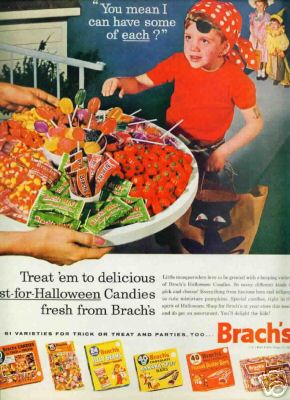
Candy Corn was a hit. By 1900, Goelitz could not fill all the orders they received. Unfortunately, the product was too labor intensive to make year round, so Goelitz only produced Candy Corn from March to November. And an annual Autumn candy was born.
Tricksters & Halloween Candy
About 1927, a new social activity began to appear. Children disguised themselves and walked from door-to-door demanding a Trick or a Treat. At first, the treats were nuts, coins, or baked goods. Consumer demand called for downsized candy. This was a boon for the confectionary industry which previously only mass produced candy for Easter and Christmas. Not only did Halloween provide another candy-intensive holiday, the perfect Autumn confection already existed.
By 1951, Goelitz had twelve factories around the country producing what had become Candy Corn.
Today 35 million pounds of Candy Corn are produced annually. [That’s 9 billion kernels.]
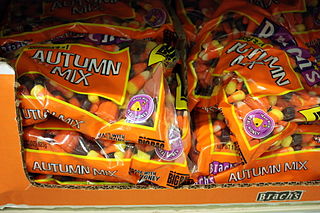
The recipe has changed a bit over the years. Key ingredients continue to be sugar and corn syrup. Additional contributions are made by sesame oil, honey, artificial flavor, gelatin, and confectioner’s glaze. Confectioner’s glaze, by the way, is also known as shellac and is produced from lac-resin which comes from the lac bug. The idea of a Halloween candy having a Yuck factor seems appropriate.
Brach’s Confections owned by the Ferrara Candy Company is the largest manufacturer of Candy Corn today. Brach’s produces 7 billion kernels of candy corn annually, which is about 85 percent of the Candy Corn found on shelves featuring Halloween Candy.
If you’d like to see how Candy Corn is manufactured, take a look.
*In 2001, Goeltiz Confectionary Company changed its name to Jelly Belly Candy Co.
Illustrations
Happy Halloween by Janine.
Reese’s Peanut-Butter Cup.
Candy Corn.
Goelitz Candy Corn Advertisement by Csavvi.
Brach Advertisement 1962.
Brach’s Autumn Mix by Krista.
Michele Debczak. “How Candy Corn Became a Halloween Staple.” Mental Floss. Sept. 20 2021.
Jessica Prokop. “The Surprising History of Candy Corn.” Candy Favorites.
Mike Snider. “Candy Corn: The Halloween Candy That Divides a Nation.” USA Today. Oct. 2, 2022.

Sandra Wagner-Wright holds the doctoral degree in history and taught women’s and global history at the University of Hawai`i. Sandra travels for her research, most recently to Salem, Massachusetts, the setting of her new Salem Stories series. She also enjoys traveling for new experiences. Recent trips include Antarctica and a river cruise on the Rhine from Amsterdam to Basel.
Sandra particularly likes writing about strong women who make a difference. She lives in Hilo, Hawai`i with her family and writes a blog relating to history, travel, and the idiosyncrasies of life.

